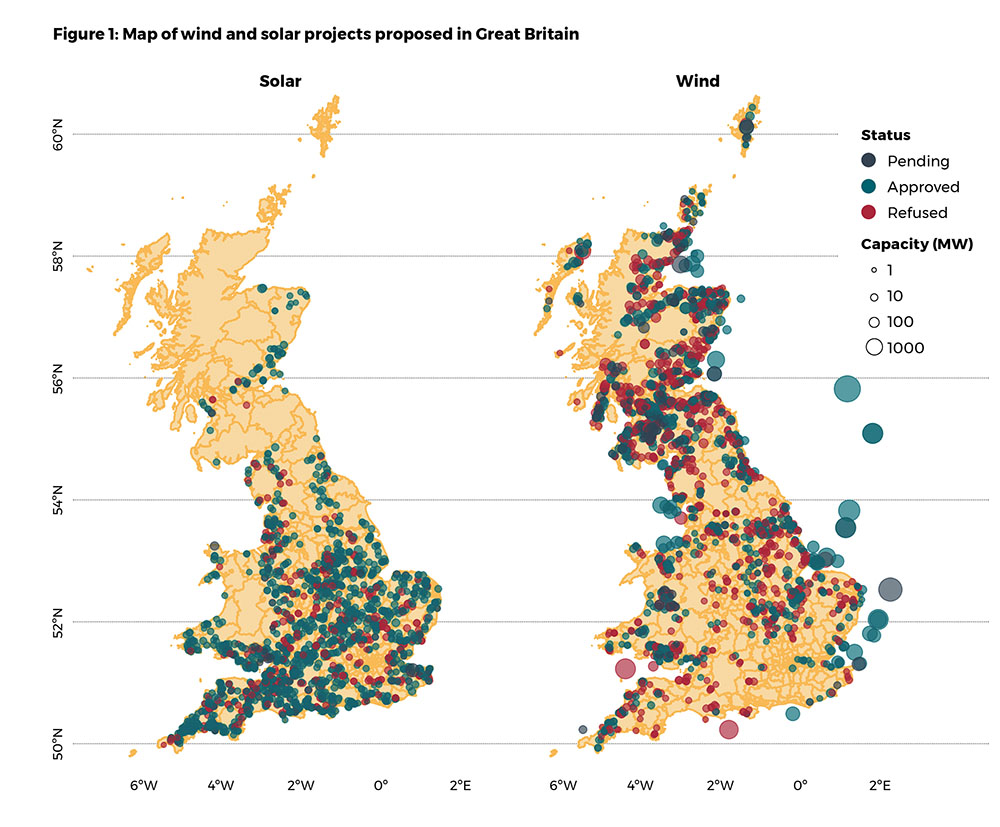by Stephen Jarvis
Tackling climate change will involve radically transforming the energy sector. To reach net-zero emissions by 2050, the International Energy Agency (2021) forecasts the need for a ten-fold increase in global wind-power capacity. For solar power it’s a staggering twenty-fold rise. Hitting those milestones means adding around 40 million football fields of solar panels and more than half a million wind turbines as tall as the Shard or the Eiffel Tower.
Where, then, is all this going to be located? Fights over infrastructure siting are hardly new, and renewable energy is no exception. In Britain, onshore wind projects have long been contentious (BBC News, 2014). Less than half of the wind projects proposed have managed to get planning permission. Even the recent enthusiasm for offshore wind is probably in part because the turbines are located far out at sea – out of sight and out of mind (The Guardian, 2020). Solar projects have tended to have an easier time, with four out of five projects proposed getting planning approval. Recently, though, even that has been changing with the emergence of larger solar projects prompting local backlash (The Economist, 2021).

It is easy to dismiss opposition to these projects as NIMBYism – the sort of Not In My Back Yard attitude we all love to decry until it is our own back yard and under the microscope. In truth, wind farms do appear to impose real external economic costs on nearby residents. One way to quantify this is to look at the impact on nearby property values. I find that the median wind project reduces the value of residential properties within two kilometres by around 4–5%. These effects are concentrated on properties in wealthier, less deprived areas with direct line-of-sight, which is consistent with the main issue being the unwanted visual impacts. For solar projects there does not appear to be much of an effect, although that may change in the future as projects become larger.
While these local impacts are important, what remains unclear is whether the current planning process does a good job of incorporating them into decisions about which projects get built and where. To study this, I examine each of the projects proposed in the UK since 1990, estimating both the local impacts (e.g., on property values) and the wider societal impacts (e.g., the costs of constructing the project and the value of the electricity produced or any emissions abated). I find that there is indeed significant variability in the local costs that wind projects impose. Furthermore, owing to the influential role local planning officials play in the UK, I find evidence that local impacts are by far the strongest determinant of whether a project is approved.
That local officials pay attention to local factors may be unsurprising – arguably they are just representing the interests of their constituents. The key here is that what may be optimal for a given local area can, in aggregate, create costly outcomes for society. In this case, the misalignment between local and wider societal incentives can lead to the under-provision of renewable energy, or the shift in development to more remote, more expensive projects. This raises the overall cost of climate change mitigation. In fact, I find that the fragmented and localised nature of the planning process has potentially increased the cost of the UK’s deployment of wind power by £8–23 billion, or 10–29%.
Some of this can probably be blamed on NIMBYism. There would be significant cost savings from approving more low-cost projects, even when these have significant local impacts. However, that isn’t the only issue here. While planning officials are responsive to variations in costs within their local area, they don’t appear to pay much heed to how those costs compare with other areas of the country. Finding ways to improve coordination at the regional or national level could therefore yield some real gains, especially where it leads to the beneficial concentration of capacity in the most productive areas.
There are a range of policies that could address some of these misaligned incentives. An obvious one is to try and keep more of the revenues created by a project within the local community. My analysis suggests that a relatively simple system of direct compensation payments could offset most of the local costs experienced by nearby residents, and often do so at a reasonable cost to developers. Schemes like this do exist in many countries, including the UK. However, they tend not to be targeted at individual residents. Moreover, their voluntary nature means provision is patchy, with disadvantaged areas at risk of being left behind. Taking steps to standardise the kinds of benefits local communities can expect from hosting a new renewable energy project could go a long way to helping countries meet their ambitious net-zero goals.
About the author
Stephen Jarvis is an Assistant Professor in the Department of Geography & Environment at the London School of Economics.
Publication details
This article is based on the paper Jarvis, S. (2021). The Economic Costs of NIMBYism: Evidence from Renewable Energy Projects. CRC Discussion Paper (CRCTR24, no. 300)
References
BBC News (2014). David Cameron says people are 'fed up' with onshore windfarms. [online] [Accessed 27 Jul. 2021].
The Economist (2021). Solar power's NIMBY problem. [online] [accessed 27 Jul. 2021].
International Environment Agency (2021). Net zero by 2050: A roadmap for the Global Energy Sector. [Online] [Accessed 27 Jul. 2021].
Guardian (2020). Boris Johnson to unveil plan to power all UK homes with wind by 2030. [online] [Accessed 27 Jul 2021].
